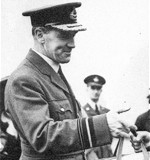| No. 20 (Training) Group RAF | |
|---|---|
 | |
| Active | 1 April 1918 – 1 October 1919 30 November 1939 – 1 August 1943 |
| Disbanded | 1 August 1943 |
| Country | |
| Branch | |
| Type | Royal Air Force group |
| Role | Military aviation training |
| Part of | RAF Training Command (November 1939 – May 1940) RAF Technical Training Command (May 1940 – August 1943) |
| Garrison/HQ | Buntingsdale Hall (1939–1943) |
| Commanders | |
| Notable commanders | Air Vice-Marshal Sir Christopher Joseph Quintin Brand KBE , DSO , MC , DFC |
No. 20 Group RAF (20 Gp) is a former Royal Air Force group which disbanded on 1 August 1943. It initially existed between 1918 and 1919, and then again between 1939 and 1943.

